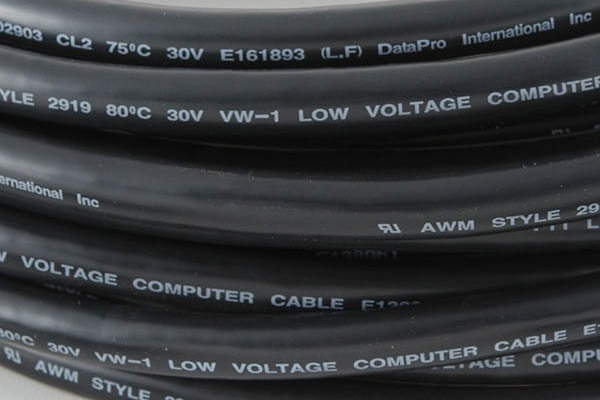
Cable Ratings & Markings
Most consumer products you see have an Underwriter's Laboratories (UL) rating for safety, and cables are no exception. Here are a few common markings you may see on the wire jacket, and what they mean.CL2 vs VW-1 - Are they equivalent?
While CL2 certification involves a similar fire resistance test to VW-1 (see below), the NEC requires the use of CL2 certified wire, and requires that it must be marked as such. So while a cable tested under VW-1 conditions may be as functionally fire-resistant as a CL2 cable, it should not be considered a code-compliant replacement.Types CL2 and CL3 cables shall be marked as Type CL2 or CL3, respectively, and be listed as suitable for general-purpose use...and shall be listed as resistant to the spread of fire.
One method of defining resistant to the spread of fire is that the cables do not spread fire to the top of the tray in the UL flame exposure, vertical tray flame test in ANSI/UL 1685-2010.
VW-1 (Vertical Wire 1)
This mark indicates that the wire has been tested in a laboratory for flame resistance. During the test, a measured section of the wire is suspended vertically and a flame source is placed near one end. A paper flag is attached to the other end of the wire. Beneath the wire sample and the flag is a small amount of cotton. The flame is ignited and the wire is burned for several cycles. The flames must not travel up the wire in such a way as to burn a significant portion of the paper flag, and none of the paper flag is allowed to drop and ignite the cotton below. (1)Full details of this test are given by ANSI / UL 1581 (2)
CL2 (Class 2)
This is one type of mark that is given to cables that meet the UL 13 "Power-limited Circuit" standard, which is designed to test the safety of cables when they are installed in buildings. There are other similar marks in the UL 13 standard for different kinds of installation, and CL2 indicates general use (3).According to the NEC (National Electric Code), CL2 cable and wire is permitted for "general purpose cable routing assemblies." Additionally, it is permitted to be installed in some, but not all, interior and concealed locations within buildings such as air handling spaces or risers.
CL2 uses a different test methodology than VW-1 that includes both burning and smoke. The test scale is also larger-scale than VW-1, incorporating a tray instead of a single section of wire. Specific details of the testing methodology is given in the ANSI / UL 1685 standard. (4)
CL3 (Class 3)
CL3 or Class 3 Circuit Wire is similar to CL2, but is rated to carry up to 300V of power, to CL2's 150V. Due to this, CL3 wire may be used in place of CL2, but not vice versa.CL2X and CL3X
CL2X cables can be used in some, but not all of the same locations as a CL2 cable, and a CL2 cable can be substituted for a CL2X cable but not the other way around. UL categorizes CMG / CM, CL3, and CL2 cables as "General Purpose", and CMX, CL3X, and CL2X as "Dwelling."CL2 and CL2X share the same allowable usage for:
- Fabricated ducts described in NEC 300.22 (B),
- Other spaces used for environmental air as described in NEC 300.22 (C),
- Risers
"1.8 With certain exceptions, as noted in 1.9, Type CL3X and CL2X cables are required by the NEC to be used with protection such as raceway. The Type CL3 and CL2 and other cables covered in these requirements that are not required by the NEC to be used in raceway are capable of use without the physical protection of raceway but may be pulled into conduit or installed in other raceway. 1.9 Type CL3X and CL2X cables are limited by the NEC to use in unconcealed spaces in which the exposed length of cable does not exceed 10 ft or 3.05 m, and in raceway. These NEC limitations do not apply to Type CL3X and CL2X cables that are smaller in diameter than 0.25 in or 6.35 mm and are used in a one-, two-, or multi-family dwelling."
The NEC limitation waiver given in UL 13 section 1.9 above also seems to apply to most consumer-grade cables, given that wire diameter for a typical device cable, such as USB or HDMI, is around 0.25" or less. The UL 758 standard includes tests for flame properties, and lists a VW-1 flame test as one possibility under in the standard's table of contents. Looking at UL 13, which defines CL2X or CL3X as:Cable[s] intended for use in Class 2 or Class 3 circuits within buildings (1) where the cable is enclosed in raceway or noncombustible tubing, or (2) in nonconcealed spaces where the exposed length of cable does not exceed 10 ft, or (3) in one- or two-family or multifamily dwellings when the cable diameter is less than 0.25 in., in accordance with Section 725.154(E) of the NEC. This cable complies with the VW-1 Flame Test requirements in ANSI/UL 1581.
AWM (Appliance Wiring Material)
This type of wire is defined by UL 758, and is meant to be used with consumer products in basic connectivity applications, such as connecting a computer to a monitor, or routing a USB cable from a motherboard to the outside of the computer case. AWM wire is not meant to be used in building installations, unless it is within the scope of the installation instructions for a particular product (5). However, there is some overlap in test scenarios between UL 758 and UL 13 (which covers CL2, CL2X, and CL3).Citations:
Check out our comprehensive Tech Info page for a selection of informative articles!






